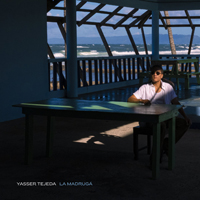
YASSER TEJEDA
LA MADRUGA (Seasick Records)
La Republica Dominicana is well-known for its own brand of traditional merengue music — which is often accordéon-led — and bachata, a speedy guitar-driven rock which everyone on the island listens to, whether they are kids or the elderly. But there are other strains at work. Yasser Tejada is a graduate of Berklee College of Music where he mastered his guitar playing and delved into the rich culture of his country. For centuries the Dominicans in the provinces have been keeping their African heritage alive and Tejeda features Congolese musical references on guitar, but also in rhythms driven by the congas as well. His small combo is versatile: Mario Castro on keyboards also plays tenor, and conguero Jblak Troncoso also sings. On "Todo va a marchar (Everything's gonna be okay)" we get the skittering Dominican rush of bright guitar, but also a nice taste of soukous (showing their affinity), then a quick dive into warbly Haitian kompa when Tejeda hits the flanger effects pedals. A Sarandunga (from Baní in the province of Peravia) delivers homage to Saint John the Baptist with a 200-year-old dance, updated. Tejeda recently brought his sound to NPR's Tiny Desk concert and delivered a solid set of four songs from his new album. "Tu ere' bonita" starts off as a ballad and amps up into a racy bachata worthy of Juan Luis Guerra. La Madruga is his debut, and furthermore is bargain-priced on turquoise vinyl!

BACHATA ROJA (iASO records iASCD3)
Anyone who has visited the Dominican Republic comes away with the latest bachata hits ingrained in their brain as a memorable part of their trip. It's speedy and electric but like anything else, it came from somewhere, and this disc celebrates the acoustic origins of the music. During the Trujillo regime, accordions played merengues all over the right half of Hispaniola. After the assassination of the dictator in 1961, guitar-backed songs gained in popularity. It's campesino music but as the farmworkers migrated to the cities with their guitars, the songs started discussing drinking, women and prostitution. So the evolution of bachata into party music also meant its descent into the bar room, and when things are loud, like there's a brawl going on, the musicians get overlooked, so naturally they had to electrify! By the late 1980s the speedy electric music we all know and love had come to dominate the sounds of la Republica. This brings to mind an anecdote from a trip to the island with my brother. One afternoon we were walking around the port in a seedy part of town when it started to rain. I saw a dark doorway and heard bachata within: "Quick, in here!" I said and ducked inside. We went down steps into a tiny dimly-lit bar & ordered two beers. We made desultory conversation with the barman and then my brother said, Check this out. I looked around and could see two women we hadn't noticed on arriving. They were dancing on a spotlit miniature dancefloor at the back of the bar. More women came downstairs and approached us to score a beer. Hey, we just walked into a brothel, I said. We made a break before we got too involved. Juan Bautista's "Estoy aqui pero no soy yo (I am here but it's not me)" is a ballad on the "Perfidia" changes. Among other gems you have to hear are Leonardo Panigua's "Mi secreto (My secret)." This album is beautifully packaged, & a real labour of love. (The title, obviously, a play on "Bachata Rosa," a huge hit for Juan Luis Guerra.) The music is consistently great and you won't have to buy a round or leave before it's over.
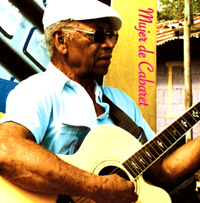
PUERTO PLATA
MUJER DE CABARET (iASO records iASCD2)
Puerto Plata is a coastal resort in Dominican Republic. It's also the nickname of this guitarist, José Manual Cobles, who hails from there. As a labourer he found it was easier to call people by where they were from than to try to remember their name. Now 83 year years old and an immigrant to the USA, this is his first album. He survived the 30-year brutal regime of Trujillo and perfected his music, which sounds very Cuban to me. I recall one afternoon laying in my hotel room in Santiago trying to kill a pain in my guts which a quack doctor had misdiagnosed as heatstroke, and as I drank the rum which made me worse, I could hear some classic Cuban son and bolero wafting up from the street from a cassette vendor's stand. Finally I roused myself and went down to give the guy a glass of rum in appreciation. Now I hear this disc I think that's what he was playing, thrown in with Trio Matamoros. It mixes well, like rum and orange juice -- but let's not go there. The album opens, indeed, with a Nico Saquito composition, a guaracha called "Amarrao con fé." It's unplugged which is great, you can really hear the skill of Edilio Paredes on the guitar which alternates between fluid runs and that brittle stumbling chicken-scratch typical of Dominican pop. Mexican as well as Cuban rhythms adapt well to this style of playing. In addition to numbers by duo los Compadres and Antonio Machin, Puerto Plata covers "Te la dejo toda" by Mexican diva Paquita la del Barrio. There are one or two original compositions thrown in among the standards, and a spare band that takes over half-way through as the fingerwork is probably too much for one pair of guitarists!
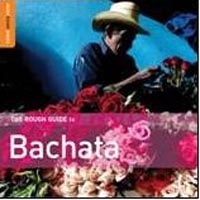
ROUGH GUIDE TO BACHATA (RGNET1164CD)
This is a fine trip down memory lane. Bachata, the vulgar step-brother of Merengue, is characterized by plucked one-note brittle guitar leads and wistful vocals over a lilting bass. If you've heard it in situ it instantly evokes tropical beaches in glaring sunlight or mirrored discos with hot babes waiting to be asked to dance. The plaintive quality of the vocals creates instant nostalgia in the listener, even if you can't figure out what for. Bachata emerged from the rural north in the 1980s to become the voice of the poor in La Republica Dominicana. I suppose it has something in common with the blues as the lyrics are either social commentary or lovers' complaints. In contrast to the stately bomp of the bass and skittering lead guitar there is a sporty bongo filling every available space with trills and counterbeats. Luis Vargas and Antony Santos, the biggest stars, are here with their love-lorn vocals. Relative newcomer Zacarias Ferreira has three selections on here, including two from his album EL AMOR VENCERA. Like those other giants of the style he has a husky voice suggesting he is choked up and barely able to articulate his feelings. A fun slice of this music, calculated to extend the summer just a bit.
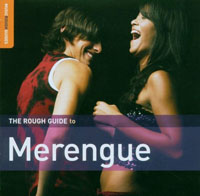
ROUGH GUIDE TO MERENGUE (RGNET 1171 CD)
It's 8 years since my first trip to the Dominican Republic, 6 years since the great Putumayo CD REPUBLICA DOMINICANA, and so it must be time for a shot of Merengue. Though Haitians claim to have originated the style, it probably came from Cuba, and while poor Haiti has gone down the sewer, their neighbours thrive as a tourist destination. I was sitting in a little thatched-roof cabana having a cold beer the evening I arrived in Sosua, when a young black girl came up to me and said in clear English, "How would you like to do me on the beach?" Quite an opening line but indicative of the impact foreign money has on a third world economy. She was quite perky for someone who would undoubtedly be dead from AIDS before she reached 21. One thing unites the Dominican Republic and that is the music. I love cultures where everyone from kids to old folks shares a passion for their national music, so you don't have the old folks grumbling and the young folks mystifying them with weird ideas. Merengue blares forth and everyone is ready to party. Dancing to it is a different story. I could grasp the hip-swiveling and side-slithering feet but could never quite get up to tempo on the dance floor. Now Merengue has joined Cumbia, Salsa and Reggaeton as a pan-Latin beat so you find it comes from Puerto Rico and Colombia as well as D.R. The biggest name on here is ChiChi Peralta from his great album PA OTRO LA'O (Caiman Records 1997). Chi Chi was with Juan Luis Guerra's group 4:40 for 8 years before launching a stellar solo career. Also here is Caña Brava from Puerto Rico who make two appearances, including their debut smash "No me faltes nunca" from 1992. The New Jersey-based Oro Sólido present their romping "Verano sólido." The music hasn't changed much since then but consistency is good. The lyrics are simple enough that you can follow them with basic Spanish; the instrumentation is also simple: saxes, accordions, guiro, bass and two-headed drums.
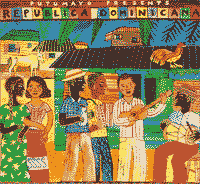
VARIOUS ARTISTS
PUTUMAYO PRESENTS REPUBLICA DOMINICANA
The island of Hispaniola has great musical diversity thanks to the two countries that share it: Haiti and La Republica Dominicana. Putumayo has just put out a CD guide to the music of the latter and it goes down smoother than a large tumbler of rum, grenadine and orange juice. The main styles of Dominican music are bachata and merengue. While merengue is known throughout the Caribbean, bachata is a unique skittery rhythm that non-Dominicans find impossible to dance to. The main exponents of the form, artists like Juan Luis Guerra and Antony Santos, also cover many others styles in their repertoires. Outstanding here are Luis Vargas doing "Tranquila," Chichi Peralta's "Procura," Juan Bautista's "Pegao de que" and "Caña Brava" by Alberto Beltrán. PUTUMAYO PRESENTS REPUBLICA DOMINICANA is so good I have to complain (once again) about how short it is.
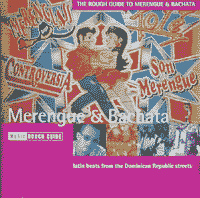
VARIOUS ARTISTS
THE ROUGH GUIDE TO MERENGUE & BACHATA (Rough Guide RGNET 1039CD)
From the first chicken-scratch riff of "Cojelo Ahí (Grab it there)" by Antony Santos, I'm back in the Dominican Republic with its speedy form of merengue, known as bachata, winding up the feet of dancers in clubs and even people on the street. The bass thumps out a solid 2/4 beat as the lead instrument, guitar or accordion, propels the hip-swivelers and the singer emotes in a voice close to distraction. Spoken exhortations and blistering guitar solos punctuate the momentum. THE ROUGH GUIDE TO MERENGUE & BACHATA doesn't include Juan Luis Guerra (the licensing must have been too steep), but equally talented bachatistas pack this set. I suppose the early Spanish influence must be responsible for the plaintive quality of the vocals. There was bolero somewhere in the roots of bachata but the light soufflé of Haitian merengue also affected the sound. The unique guitar quality is simply an electric guitar without effects (no reverb) -- what a novelty!